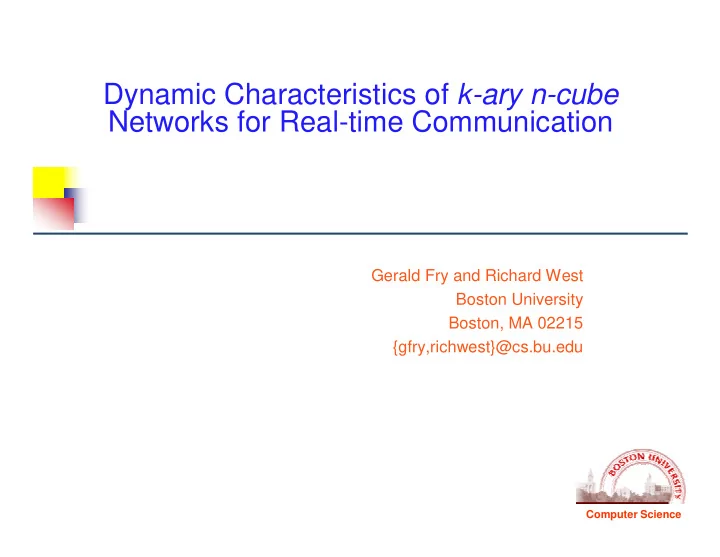

Dynamic Characteristics of k-ary n-cube Networks for Real-time Communication Gerald Fry and Richard West Boston University Boston, MA 02215 {gfry,richwest}@cs.bu.edu Computer Science
Introduction Computer Science � Overlay topologies have become popular in Peer-to-peer (P2P) systems � Efficiently locate & retrieve data (e.g., mp3s) � e.g., Gnutella, Freenet, Kazaa, Chord, CAN, Pastry � Previous work � Static analysis of k-ary n-cube graphs for structuring overlay topologies � Basis stems from interconnection networks in parallel architectures, such as SGI Origin 2/3000 � Focus on delivery of real-time data streams
Dynamic Characteristics Computer Science � Internet-scale overlays are inherently more dynamic than tightly coupled interconnection networks: � Transient mappings of physical host addresses to logical node identifiers � Adaptation of logical positions of publishers and subscribers to satisfy QoS constraints � Hosts joining and departing from the system � Must adapt the overlay structure to maintain connectivity and optimal hop count
Contributions Computer Science � Focus on dynamic analysis of k-ary n-cube logical networks � Methods for performing M-region transitions � Calculation of message exchange overheads for join and departure events � Quantify lag effects of join/departure bursts � Applications: live video broadcasts, resource intensive sensor streams, data intensive scientific applications
Properties of k-ary n-cube Graphs Computer Science � M = k n nodes in the graph � If k = 2, degree of each node is n � If k > 2, degree of each node is 2n � Worst-case hop count between nodes: � n � k/2 � � Average case path length: � A(k,n) = n � (k 2 /4) � 1/k � Optimal dimensionality: � n = ln M � Minimizes A(k,n) for given k and n
M-region Analysis Computer Science � Hosts joining / leaving system change value of the number of physical hosts, m � Initial system is bootstrapped with overlay that optimizes A(k,n) � Let M-region be range of values for m for which A(k,n) is minimized � As m changes, M-region transitions restructure the overlay to maintain optimality � In previous work, we derive the first sixteen M-regions
Join/Departure Events Computer Science � Each join/departure event requires a number of control messages to be exchanged � Necessary for maintaining global consistency of routing state � An individual event requires O(n) message exchanges � Worst case message exchange overhead is independent of the occurrence of an M-region transition
Adaptation Lag Computer Science � Assume join/departure events arrive in bursts of size b � Given the dimensionality, n, of the overlay, the adaptation lag = n • b • C � C is a constant proportional to the average transmission time of a single message � Simulation investigates effects of adaptation lag due to join/departure burst requests � MMPP used to generate bursts � Target and actual M-regions recorded at discrete time intervals
Simulation Results Computer Science C = 10 -6 , Target M-region utilization = 84.4%
Conclusions/Future Work Computer Science � Analysis of dynamic characteristics of k-ary n-cube overlays � Routing state maintenance due to host joins and departures � Optimal topology wrt. average and worst-case hop count as the system evolves � Future Work � Build scalable overlay topologies and analyze performance in practice � Integrate end-host architectures for user-level sandboxing � Multicast tree construction in k-ary n-cube networks
Recommend
More recommend